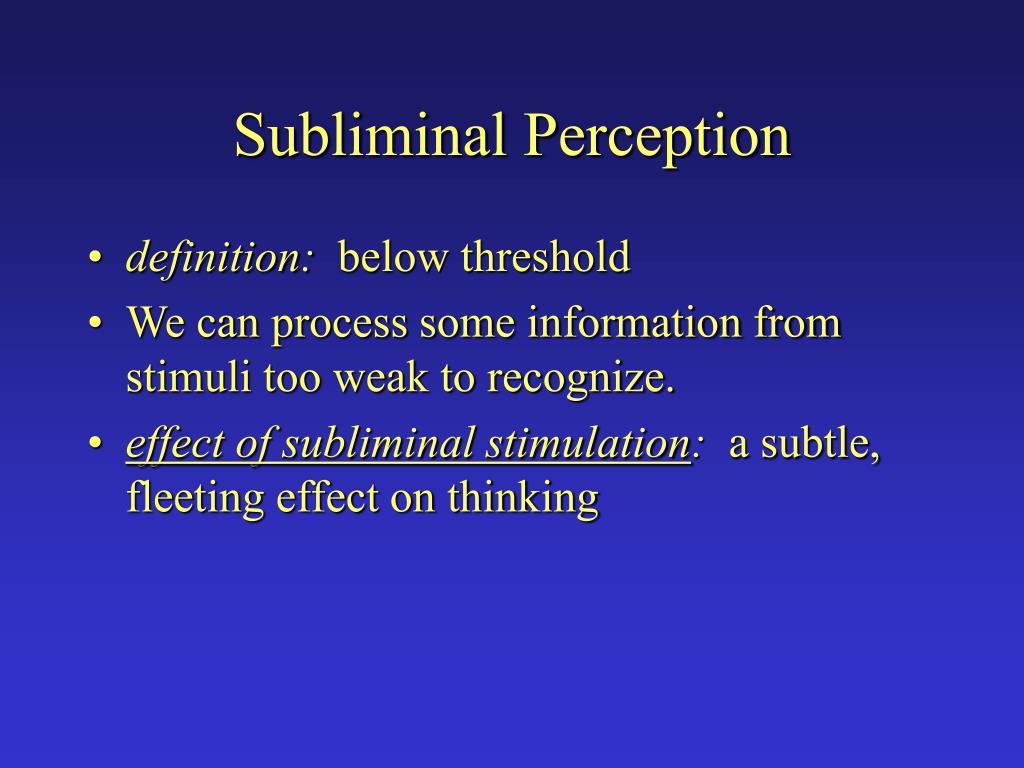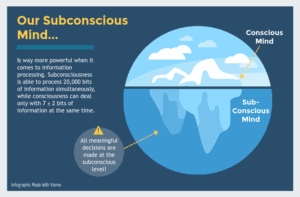

- #Subliminal perception seems to work by influencing movie
- #Subliminal perception seems to work by influencing trial
#Subliminal perception seems to work by influencing trial
Researchers also computed the LDA for a portion of the trial when the subliminal image was not being presented and found that LDA performance was not different from chance levels. They found that LDA performance was significantly higher than chance level, meaning the neurons encoded the orientation of the natural image. Once the model was trained, researchers could then input the firing rates from the remaining 10% of trials and test the model, by letting the model categorize each trial by image orientation.

For 90% of the trials, they input firing rates from when the natural image was displayed and “trained” the model by pairing firing rates with the correct image orientation. In this case, researchers tested whether the LDA could separate trials based on which orientation the natural image was presented at. LDA is a supervised learning model that attempts to classify data into different categories. Pojoga used a linear discriminant analysis (LDA) to decode neural responses to the natural images. Researchers could then align the trials at the time the subliminal natural image was present and analyze the data for any changes in neural activity. The inserted natural image was presented in its original form or rotated 5-20 degrees. At a random point in each trial, a novel natural image was presented for two consecutive frames instead of the oriented grating. Subjects performed tasks to test whether brain activity or behavioral performance changed due to subliminal image presentation.Īgain, animals fixated on a central point on a computer screen while an oriented grating appeared. The authors addressed this in a follow-up experiment. But the question remains if and how the brain registers these images. The authors had found that they could present images below the level of conscious detection. However, subjects only guessed the correct image at chance level when the images were presented for two frames, meaning the images were below the subjects’ threshold for detection, making them subliminal. The authors found that subjects could easily identify the image when it was imbedded for five frames. The natural images (such as a photograph of an animal) were imbedded in an oriented grating for either two or five consecutive frames, 33.3 and 83.3 ms respectively. In a recent study, Pojoga and colleagues designed a task which would subliminally expose rhesus macaques to a set of natural images while recording from neurons in the primary visual cortex. Sorin Pojoga, a member of Valentin Dragoi’s lab, set out to determine the neural underpinnings of subliminal images and how this brain activity changes our behavior. Though the behavioral change has been established through multiple publications, we still don’t know how the brain processes subliminal images. However, there is evidence dating all the way back all the way to the 1960’s, which suggests that showing subliminal images improves behavioral performance. Importantly, and thankfully, subliminal messaging is not capable of brainwashing. So, does subliminal messaging actually affect us? Although the results were later proved fraudulent, the researcher, James Vicary, claimed that presenting these suggestive messages increased concession sales.
#Subliminal perception seems to work by influencing movie
To test if subliminal messages could sway behavior, short messages stating, “Drink Coca-Cola” and “Hungry? Eat Popcorn” were played in a movie theater during a film.

One of the most famous examples of subliminal messaging was conducted in the 1950’s. On the other hand, supraliminal messages are presented for longer periods of time, such that we can consciously see them. Usually we think of short frames cut into a video feed, where the subliminal message appears so quickly (usually less than one tenth of a second!) that our minds do not register their appearance. What does subliminal messaging entail? Subliminal messages are words or images presented below our conscious awareness. New research from Valentin Dragoi’s lab at the University of Texas at Houston suggests that subliminal images can change our brain activity and behavior. Subliminal messaging – we’ve all heard about it.


 0 kommentar(er)
0 kommentar(er)
